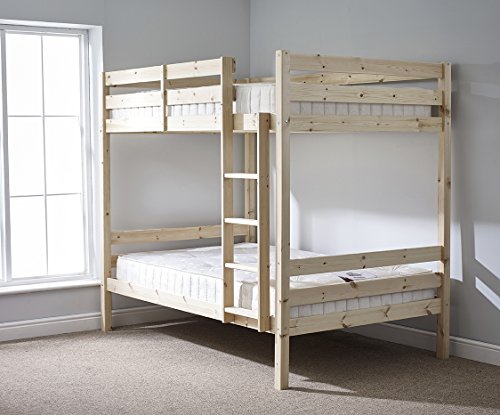Are The Advances In Technology Making Bunk Bed With Double Bed Better Or Worse?

Buying a Double Size Bunk Bed
A bunk bed brings aesthetics and practicality to a bedroom. It's the ideal choice for siblings sharing a room or teens looking to let their friends sleep over.
Consider the ceiling height of the room when you are looking for the perfect double-sized bunk bed. Also, decide if you want the bottom bunk to have a trundle so that guests can sleep there. Find a step or ladder that is wide enough for teens and children of smaller ages to climb.
Size
If you're thinking about buying bunk beds for your home, there are many alternatives available. There are many options that include twin over twin, twin over full or even triple bunk beds. These bunk beds are designed to accommodate two or more people, so you can make the most of your bedroom space without sacrificing safety or comfort. Bunk beds can also be removed to create two twin beds if you need. You can repurpose the bunk bed in case your children do not use it anymore or you want to save money on headboards or foundations.
It is important to keep in mind that the dimensions of your bed will determine which mattress is best for you. You can choose a twin-sized mattress for the top bunk, or a twin mattress which is 5 inches wider. This is a great option for teens as it gives extra length to taller sleepers. You can also choose a futon-style bunk that features a pull-out couch at the bottom of the frame and offers more sleeping space for adults or teenagers.
The height of your bunk bed must be considered in order to avoid having to buy one that is too high and you risk hitting your head against the ceiling when lying down. In general you should have six to eight inches between the mattress and upper guard rail so that sleepers can sit comfortably in their bed.
You might also consider the size of your ladder for bunk beds depending on the size of the room. Most bunk beds come with a straight ladder, but you can also purchase angled or staircase-style bunk bed ladders. Staircase-style ladders occupy more space, but are generally safer to use than straight ladders. Bunk bed ladders are also available in different heights, which is useful for kids who are growing older and will have to move rooms.
Some bunk beds are designed to be separated into separate lofted beds which allows more floor space for a desk, dresser, or toys. This is a great solution for older children or teens who do not want to share a room.
Material
Double bunk beds are available in various materials. Solid wood is the most durable and solid option, while cheaper metal is a good alternative for shoppers with a tight budget. Bunk beds are also available in engineered and particleboard wood. However, these types of wood do not last as long as solid wood, and they may emit volatile organic compounds (VOCs) which could have adverse effects on children's respiratory, immune or allergic systems.
The height of the top bunk is an important aspect to consider when selecting the right bunk bed. A bunk bed that is too high could cause people to fall off the top bunk, or even hit their head on the rails. In general, a bunk bed should not be higher than six feet from the floor.
This bunk bed with trundle provides a contemporary look and timeless design. The sleek frame fits neatly into the corner of your child's bedroom, and the space underneath can be used as a study area with a desk, or a peaceful retreat with plush throw pillows and an attractive comforter. This stylish bunk bed is crafted of kiln-dried pine wood and durable engineered wood for long-lasting durability and strength. The bed is hand-finished by skilled craftsmen using a a fresh finish that you can choose from white, seadrift, or weathered navy. A polished nickel or oil-rubbed bronze hardware complements the bed's clean lines.
bunk bed single and double are ideal for children who have outgrown their the toddler's bed but are too tall to fit into traditional twin beds. These bunks are also perfect for adults who wish to share the bedroom with a younger child or college student in a small apartment. The twin-over-full bunk bed comes with a ladder and two drawers underneath the bed that are ideal for storing bedding and clothing.
This bunk bed does not require box spring or foundation, unlike traditional bunk beds. Instead the beds are placed on one another and can be used to accommodate the traditional or memory foam mattress. Although memory foam mattresses are popular for their comfort, they can be more expensive than innerspring or coil mattresses.
Design
If your children share in a room, bunk beds can offer more sleeping space, but without taking up more floor area. Bunk beds are available in a variety of styles and configurations. Many even have extra features like tables that are built-in, stairs, and trundles. While you can buy bunk beds that are already made at many major furniture stores however, you can also create your own custom-designed bunk bed at your home to fit any space size and style.
When deciding on a bunk bed, it is important to take into consideration the space in your bedroom and the ceiling's height. Larger rooms can accommodate a larger mattress and smaller ones will require twin mattresses to keep from overcrowding. Additionally, you should ensure that your children's heads will not be struck by the ceiling when they sleep on the top bunk.
A basic bunk bed could be made with two twin-size mattresses, while other variations feature full-size mattresses on the bottom and a twin mattress on the top. These bunks are ideal for siblings sharing a single room or older children who want more space to play and study. They are a great choice for bedrooms with limited space, as they free up floor space for furniture pieces, such as dressers desks, and toy boxes.
Other types of bunk beds include loft beds, which can be used as an office or playroom and can also be used as a bed for guests to visit. These beds are available in a variety of finishes ranging from modern to classic, and are often made using sturdy wood. Some even come with built-in shelves to store books and other items.
Another type of bunk bed is the L-shaped double bunk that offers more privacy and can be set up with different styles to match any bedroom. It is also extremely secure, as it has an inbuilt desk and staircase with safety rails. This makes it an ideal choice for children who need to finish their homework or do other things in the bed.
If you're on less of a budget, you might be interested in a double-over queen-sized bunk bed that comes with a built-in trundle and stairs. This bunk bed has more storage space and can hold more guests than an ordinary bed. Its spacious design is perfect for teens and can be customized to match any decor or finish.

Safety
Although injuries to the bunk bed may occur but they are usually caused by the way that children use the beds, not the design or construction. With a few basic safety precautions, bunk beds can be used safely by children of all ages.
Before you put together your bunk bed, determine the location you'll put it, and measure the room's different dimensions. This will allow you to determine if the bed is going to fit and whether there's enough room to sleep or play. Be sure to check the ceiling's height to avoid placing the bunk beds in ceiling lights or fans.
Follow the instructions given by the manufacturer when making your bunk beds. This will ensure that all the components are fitted correctly and that your bed is sturdy. Replace any worn or damaged parts. Make sure the ladders on the bunk beds are secured and are able to support your child's weight and any guests who may be sleeping over.
Learn the rules for your children for using bunk beds. For instance, the top bunk is for sleeping only and shouldn't be used for games or jumping. The ladder must also be attached to the bunk, and should not be placed close to any furniture or toys that might entice youngsters to climb it. Children should also be taught how to climb the ladder carefully and slowly.
When making your bunk bed consider using a ladder that attaches to the side of the bed instead of one that is underneath it. This will reduce the chance of falling or getting caught with bedding or clothing. Also, consider installing an evening lighting in the room next to the bunk bed. This will give your children more safety when they climb into and out of the bed at the night.
It's an excellent idea to test the openings and spaces in the guardrails and the mattress foundations prior to letting your children sleep on them. Ideally, these should be no more than 5 inches wide and not located in the places where children's heads may be struck when they sit up straight in the upper bunk.
